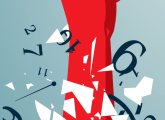Students often share their feelings on art education during their lessons with me, often including words like ‘sanctuary’, or describing a ‘second home’, and feeling ‘connected to the wider world’. There is much opportunity for contemplation within the ebb and flow of physical interaction with materials; collaborations; focused concentration; and the exploration of culture and imagination that the study of art embraces.
Fundamentally, my job as an art teacher is giving young people permission to discover; to realise that within us all is creativity. The average eleven year old still feels creative, but if you ask most adults, or even teenagers, it’s likely that they perceive themselves as not being so. Making (music, performance, dance and art specifically) allows for a learning experience which promotes individuality and creativity in its broadest sense – and whilst I understand how creative thinking and problem solving is nurtured by my colleagues across all subjects, I feel there is still a genuine question to be asked of the education system in the sense of how it understands the world for which is is aiming to prepare our students.
Growth through change
I am not expecting all my students to become artists, but I know that the experience of studying art is transformative. During the time they have studied, they have been problem solving, designing, referencing, exploring, experiencing, sharing and making. They have realised a potential which cannot be expressed in the form of answers on a test sheet. They have felt materials in their hands, gathered clay dust on their uniforms and, sometimes, come to the realisation that a piece was not working and they needed go back to the drawing board, tackling it in a different way.
Art allows students to feel genuine pride because they have not merely proven that they have processed, or can recall, but rather, that they have created something. That is a very powerful feeling, which gives rise to all sorts of understandings about self. A wonderful colleague of mine, the internationally recognised sculptor Oliver Barratt, articulated so accurately and beautifully what we do, saying, “There is an intangible algorithm involved in every act of making that has both shared and unique qualities. This making algorithm requires an informed cultural intelligence, an enjoyment of uncertainty, a tenacious belief in a far-off solution and a delight in material matter, the thread and dust of the workshop.”
The very bottom line of education should be about preparing young people for their future. We must provide in a well-rounded education the variety that enables students to lean towards the subjects they feel naturally drawn to, whilst celebrating their achievements across all areas of the curriculum and giving them ample opportunities to succeed. Why is it then that the focus of so much of education is about forcing students to do averagely well in subjects which do not interest them, whilst removing the opportunities to excel at those in which they might?
Heart of the matter
Art should be a prized activity. We should be delighted that our students can express themselves and explore. The current curriculum plans seem more about tradition than about tackling the dynamic changes in society and shifts in focus for the new working young. Is it helpful for schools to have a hierarchy of subjects in which art, drama and dance are easy to dispense with when more maths and English tuition is required? Or to make the assumption that every student wants to go to university, and that this is the sole focus of their education? To suggest it is not important to feel confident, to gain a range of skills and to explore employment in the field which is likely to bring more pleasure to each individual? Everything about the planned changes seems counterintuitive to giving students an education full of opportunities to suceed and helping them to build positive self-esteem.
At the heart of schools in this country beats the drum of a dedicated staff who want every student to get the best experience from their education; to be elevated rather than restricted; to be given the opportunity to sense worth and chances to feel genuinely surprised at their own developing talents. When our students exhibit at the end of their courses, there is an almost tangible sense of pride. Each student has made something; transforming thought into tangible reality. The same is true of performance, bringing the text to life, or finding the rhythm of the music forcing one’s feet and body to move. Those making the decisions about what is important in education should remember the rooms where thoughts are made, where ideas are conceived and where they grow into completed works; that is the essence of creativity, and it is where real magic happens.
ABOUT THE AUTHOR
Emma Delpech is an artist, who teaches at Sevenoaks School www.emmadelpech.com








